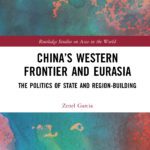Name of the Book
Zenel Garcia. 2021. China’s Western Frontier and Eurasia: The Politics of State and Region-Building (New York: Routledge)
What’s the argument?
The Belt and Road Initiative (BRI) originated in provincial-level efforts that sought to simultaneously integrate interior and frontier provinces to the rest of China as well as neighboring countries during the 1990s.
In fact, the six overland corridors that make up the BRI are a product of these early efforts. For example, Xinjiang’s “double-opening” strategy during the 1990s set the foundations for three of the current BRI corridors: New Eurasian Landbridge, the China-Central Asia-West Asia Economic Corridor, and the China-Pakistan Economic Corridor. As these provincial initiatives got underway, local officials lobbied central authorities to provide assistance. The center, in turn, enacted national-level policies, such as the Great Western Development strategy, during the 2000s. These incorporated many of these provincial initiatives.
Why did Beijing consolidate and expand these earlier, local efforts? The Chinese Communist Party’s (CCP) considered the widening development gap between coastal and interior provinces as a source of political instability. It also saw nationally-directed infrastructure projects as an opportunity to extends its reach into peripheral regions of the country.
The international dimension of these earlier initiatives treated partner countries mostly as sources of extractive resources, such as hydrocarbons and minerals. It soon became clear that this wasn’t enough to generate sustainable development and address the widening developmental gap. The BRI thus brought with it a focus on increasing the capacity of partners to participate in the wider Chinese market. Hence its emphasis on economic development projects, including power plants, industrial parks, and transportation infrastructure.
Why should we care?
My analysis demonstrates that the BRI is first and foremost about domestic politics. The BRI’s geostrategic effects are byproducts of internal concerns. This becomes even clearer when we recognize that BRI projects are negotiated by many different local and central officials. There simply is no master strategic logic guiding the BRI.
Why will we find the book persuasive?
I rely on official documents and secondary sources to trace discourses on development and security. Furthermore, I analyze the ways in which CCP officials have mobilized these discourses to support the various phases of initiatives. Lastly, I link these discourses to empirical cases, focused on Xinjiang and its neighbors, to trace how the dynamics I identify unfolded over three decades.
Why did you decide to write it in the first place?
I was researching CCP interpretations of regional formation and transformation for another project. I started to notice the patterns linking domestic and regional policies, and I decided that I needed to take a deeper dive into those patterns.
What would you most like to change about the piece, and why?
I wish that I could’ve conducted more fieldwork. I just didn’t have the funding for it. I also would’ve liked to have added a close study of the province of Yunnan. Five out of the six corridors originated from local policies in Xinjiang and Yunnan. I guess this means I can write a second book about the origins of the BRI.
How much difficulty did you have getting the piece accepted?
The process was much faster than I anticipated. I reached out to the editor at Routledge and submitted my prospectus, along with the introduction and the empirical chapters. It only took about three weeks for the reviewers to provide their feedback on the project. They provided very helpful comments and saw no need for major revisions. In the end, it took only 13 months from submission to publication.



0 Comments